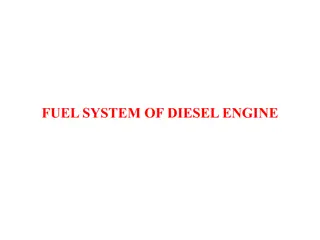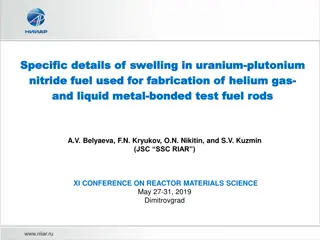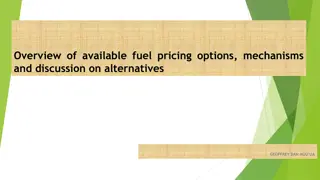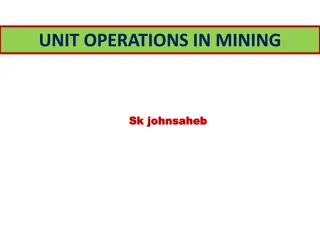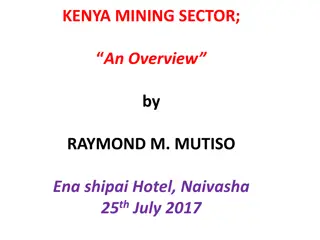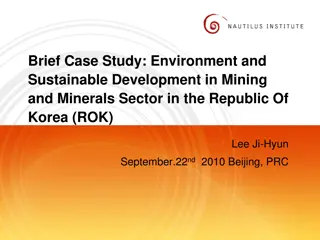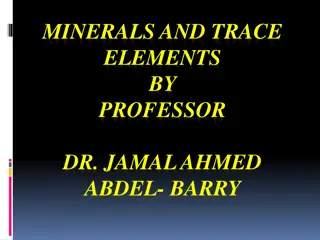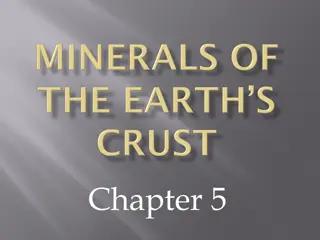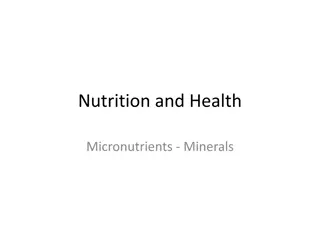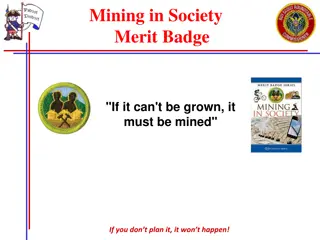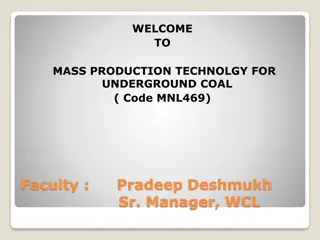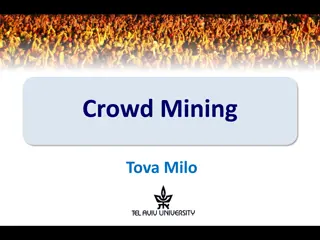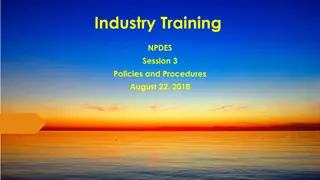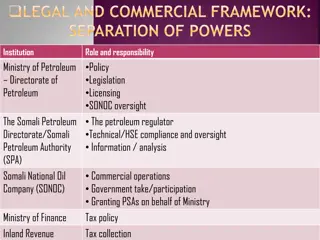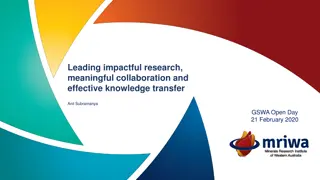Non-Fuel Minerals and Mining Sector in India: Brookings Institution Analysis
Presentation by Brookings India Center outlines key aspects of the non-fuel minerals and mining sector in India, including economic analysis, regulatory improvements, and supply chain concerns. The research agenda aims to influence policy through a comprehensive socio-economic evaluation and learnings from global mining jurisdictions.
Download Presentation

Please find below an Image/Link to download the presentation.
The content on the website is provided AS IS for your information and personal use only. It may not be sold, licensed, or shared on other websites without obtaining consent from the author. Download presentation by click this link. If you encounter any issues during the download, it is possible that the publisher has removed the file from their server.
E N D
Presentation Transcript
BROOKINGS INDIA QUALITY. INDEPENDENCE. IMPACT Non-Fuel Minerals and Mining in India Presentation to The Office of the Principal Accountant General (Audit), Bihar Outline of the Work Brookings Institution India Center, New Delhi September 23, 2019
Outline of NFM&MIN Work Three strands: positive economics, international good practices, normative economics India lags behind Mining sectors linkages with other sectors of the economy Post-leasing clearance mechanism to improve mining regulation Brookings India Sustainable State Mining Attractiveness Index Critical Minerals Supply Chain India needs to assert
Rajasthan Madhya Pradesh Jharkhand Chhattisgarh Odisha Gujarat Andhra Pradesh Goa Karnataka
Work Program Activities Advisory Council constituted with representation from various stakeholders Suman Bery: Non-resident Fellow, Bruegel The Brussels-based economic think tank Arun Kumar: Board of Petronet LNG Ltd and former Secretary, Ministry of Mines Vikram Singh Mehta: Chairman, Brookings India Ajit Ranade: President and Chief Economist, Aditya Birla Group Rajiv Shekhar: Professor and Director, IIT (ISM), Dhanbad Discussions with stakeholders, experts, international institutes Outputs include commentary briefs, papers, case studies, and reports
Work Programme Research Agenda A comprehensive socio-economic analysis of the Non-Fuel Minerals and Mining Sector in India with an aim to influence policy Positive Economics International Good Practices Normative Economics What is the status of the efficiency of mining activities? What are the learnings from other mining jurisdictions? What are the externalities and what ought to be done?
Work Programme Positive Economics Topics of study include: Allocation Captive/Merchant Exploration Extraction Regulation Royalties and taxation Logistics and operations Public versus private players Trade policy
Work Programme International Good Practices What are the experiences of other mining countries: Advanced economies Australia and Canada Developing economies Chile, Mexico, Brazil, South Africa
Work Programme Normative Economics Topics of study include: Local Cooperative mining Environment communities Sustainable Development Goals Mine closure
Outline of NFM&MIN Work Three strands: positive economics, international good practices, normative economics India lags behind Mining sectors linkages with other sectors of the economy Post-leasing clearance mechanism to improve mining regulation Brookings India Sustainable State Mining Attractiveness Index Critical Minerals Supply Chain India needs to assert
Importance of the Non-Fuel Mining Sector in Indias Economy Share of Value of Output: 2018-19 India currently produces 88 non-fuel minerals (10 metallic, 23 non-metallic and 55 minor minerals) with production value of US$ 17.3 billion (2018-19) Sector s share in the overall Gross Value Added (GVA) is less than 1% 4.4% 0.7% 6.6% 9.9% 47.9% 30.4% Minor Minerals Other metallic minerals Zinc concentrate Iron ore Limestone Other non-metallic minerals
Indias Potential to Convert Resources to Reserves 100% 80% 60% 40% 20% 0% Chromite Zinc metal Silver metal Copper metal Manganese ore Bauxite Iron ore Gold metal Nickel ore Reserves Remaining Resources Total resources (million tonnes) 344 36 29982* 12 496 3897 33276 655* 189 Source: data.gov.in mineral resources and reserves *silver and gold in tonnes
Number of Exploration Companies and Exploration Budget: 2015 Exploration Companies and Budgets by Country 500 1250 Exploration budget (US$m) Number of companies 400 1000 300 750 200 500 100 250 0 0 Canada Australia United States Chile Peru China South Africa Indonesia India Number of companies involved in exploration Total exploration budget Source: SNL Finance
Fraser Index: India lags behind Jurisdictions by Rank - 2016 101 1 Rank (out of 104) 81 21 61 41 41 61 21 81 101 1 Investment Attractiveness Policy Perception Best Practice Mineral Potential Source: Fraser Institute Survey of Mining Companies
Outline of NFM&MIN Work Three strands: positive economics, international good practices, normative economics India lags behind Mining sectors linkages with other sectors of the economy Post-leasing clearance mechanism to improve mining regulation Brookings India Sustainable State Mining Attractiveness Index Critical Minerals Supply Chain India needs to assert
Input-Output Transactions Table India 2015-16 Quantitative economic model Represents interdependencies of various sectors in an economy Used to calculate the Output, Employment, and Income Multipliers Published by MoSPI till 2007-08; Supply and Use Tables since then
Input-Output Transactions Table India 2015-16 8 non-fuel mining sectors of the I-O Table: 131-Sector I-O Table constructed using Supply and Manganese ore Iron ore Bauxite Use Tables 2015-16 Other metallic minerals Transaction flows show inputs Copper ore to mining and usage of ores Other non- metallic minerals Limestone Mica in manufacturing sectors Fuel minerals includes coal, crude petroleum, and natural gas
Output Multipliers 2003 / 2004 2007 / 2008 2015 / 2016 1.590 1.399 1.657 1.336 1.250 1.453 1.439 1.382 1.604 1.495 1.298 Coal and Lignite Natural Gas Crude petroleum Iron ore Manganese ore Bauxite Copper ore Other Metallic minerals Limestone Mica Other non metallic minerals 1.546 1.379 1.630 1.514 1.256 2.338 1.491 1.657 1.511 1.763 1.205 1.705 1.731 1.673 2.029 1.237 1.486 1.428 1.698 1.972 1.475 1.502
GVA Multipliers 2003 / 2004 2007 / 2008 2015 / 2016 0.965 0.973 0.951 0.971 0.986 0.967 0.968 0.976 0.956 0.974 0.980 Coal and Lignite Natural Gas Crude petroleum Iron ore Manganese ore Bauxite Copper ore Other Metallic minerals Limestone Mica Other non metallic minerals 0.953 0.931 0.341 0.954 0.965 0.806 0.966 0.930 0.962 0.900 0.874 0.963 0.953 0.963 0.943 0.988 0.969 0.972 0.973 0.854 0.975 0.945
Outline of NFM&MIN Work Three strands: positive economics, international good practices, normative economics India lags behind Mining sectors linkages with other sectors of the economy Post-leasing clearance mechanism to improve mining regulation Brookings India Sustainable State Mining Attractiveness Index Critical Minerals Supply Chain India needs to assert
Regulating the mining sector: Key areas and authorities Mineral conservation and development Granting mineral concessions/permits Involves mining plan, scientific mining including mine closure, optimum resource utilization Includes reconnaissance permits, mine leases (ML)/ prospecting cum mining leases Ministry of Mines (MoM), State Mining Department Indian Bureau of Mines (IBM) Displacement and rehabilitation issues Green clearances and permits Public consultation, resettlement of project affected people, forest rights Environment & forest related State Government, District administration, Panchayati Raj Institution members Ministry of Environment, Forest and Climate Change (MoEF&CC) and allied agencies; District authorities
Post mine leasing: Major clearances and permits Clearance type Principal Act Nodal authority Environmental Clearance (EC) including public hearing Environment (Protection) Act (EP Act), 1986* MoEF&CC; State and district impact assessment authorities (SEIAA & DEIAA) Forest Clearance (FC) including forest rights settlement Forest Conservation Act, 1980 MoEF&CC Wildlife Clearance (WLC) (recommendation) Wildlife Protection Act, 1972 National Board of Wildlife (NBWL) Consent to Establish (CTE) Water Act, 1974 & Air Act 1981 State Pollution Control Board (SPCB) Consent to Operate (CTO) (renewable every 5 yrs) Water Act, 1974 & Air Act 1981 SPCB * Environmental Impact Assessment (EIA) Notification, 2006 specifically provides for EC
Issues with the current clearance and permit mechanism The assessment of impacts of a mining project is fragmented, particularly for projects that involve diversion of forestland. No comprehensive assessment document for all major clearances. Authorities look into separate documents, makes assessment complex- EAC looks into EIA report , EMP and mining plan prepared by consultants. FAC looks into site inspection reports prepared by forest officials. No impact assessment report for forest clearance. Relies on 5 forms to be verified by different forest officials at the state level.
Issues with compliance monitoring Poor capacity of authorities makes compliance weak. For example, 10 regional offices of MoEF&CC monitors thousands of EC & FC compliance. Clearances/ permits coming with overlapping and lengthy compliance conditions worsens compliance monitoring EC comes with 45-50 conditions, FC with 45-50 conditions, CTE with 30-35 conditions, CTO with10-15 conditions. Availability of bi-yearly compliance reports by companies grossly sub-optimal. For example, only 30% compliance reports available for all iron-ore mining projects cleared since 2014.
Issues Impeding the Growth of the Sector: Community Engagement Lack of efforts for timely and proactive community engagement, during process such as- Land acquisition and social impact assessment Public hearing (key pre-requisite for Environmental Clearance) Settlement of Forest Rights (key pre-requisite for Forest Clearance) Decisions on DMF fund use and how local community should benefit Poor utilization of DMF funds undermining it s potential for poverty alleviation and overall development. Only 20% of the total money collected so far. A key focus of DMF investments is on physical infrastructure- roads etc.; very low investments on healthcare resources, child nutrition, livelihood etc.
Outline of NFM&MIN Work Three strands: positive economics, international good practices, normative economics India lags behind Mining sectors linkages with other sectors of the economy Post-leasing clearance mechanism to improve mining regulation Brookings India Sustainable State Mining Attractiveness Index Critical Minerals Supply Chain India needs to assert
Brookings India State Sustainable Mining Attractiveness Index (BI-SSMAI) BI-SSMAI A composite index, which will give a snapshot of the mining environment & investment attractiveness in key states / mining jurisdictions of India. Objectives: Provide various stake-holders an understanding of the potential of mineral resources led development Identify factors that encourage or discourage mining investments Suggest policy actions and practices to the Government to enable sustainable mining in the jurisdictions Provide mining companies with a benchmark for guiding investment decisions
Brookings India State Sustainable Mining Attractiveness Index (BI-SSMAI) Pilot studies to be undertaken in key mining districts / states across India Study will involve quantitative and qualitative evaluation (through perception-based surveys) of various indicators under 5 key pillars: 1. Obvious Geological Potential (OGP) and mineral development 2. Policy and Governance 3. Infrastructure 4. Environment 5. Community engagement and welfare programmes A final aggregate score will be given to each of the pillars (after scoring the indicators) and an overall jurisdiction-based index will be computed
Evaluation Parameters Pillars of BI-SSMAI Obvious Geological Potential (OGP) and Mineral Development Policy and Governance Infrastructure Community Engagement and Welfare Programmes Environmental Impact
Study Areas of BI-SSMAI Representative mining jurisdictions: Significant ongoing mining activity Untapped mineral development potential Low economic and social development Significant proportion of marginalised or tribal communities Various types of mine operators (public and private) 7 Pilot States Rajasthan Madhya PradeshChhattisgarh Jharkhand Gujarat Odisha Karnataka
Outline of NFM&MIN Work Three strands: positive economics, international good practices, normative economics India lags behind Mining sectors linkages with other sectors of the economy Post-leasing clearance mechanism to improve mining regulation Brookings India Sustainable State Mining Attractiveness Index Critical Minerals Supply Chain India needs to assert
Critical Minerals Economic importance and the supply-side risks Even if a mineral is used in small quantities in a high-value-add sector Highly complex global supply chains China produces 63% of world s output of rare earth elements (REEs) More than 70% of cobalt is mined in the Democratic Republic of Congo, with China having a majority ownership of these mines Australia produces 55% of world s lithium with China as its major importer South Africa mines 72% of world s platinum output
Mining Reforms: Atmanirbhar Bharat Introduction of a seamless composite exploration-cum-mining-cum- production regime 500 mining blocks would be offered through an open and transparent auction process Introduce joint auction of bauxite and coal mineral blocks to enhance the aluminium industry s competitiveness Remove distinction between captive and non-captive mines Commercial mining in coal sector
Mining Reforms: Atmanirbhar Bharat New Horizons of Growth Incentives shall be provided for promotion of New Champion Sectors including manufacturing of solar photovoltaic (PV) and advanced cell battery storage. Initiatives in sectors such as mining, defence production, aircraft maintenance, civil aviation, space activities, power and atomic energy KABIL Khanij Bidesh India Ltd. NALCO, HCL, and MECL (2019) Investments needed in solar panels, lithium batteries, solar charging infrastructure and other advanced technologies in India
Mining Vision Statement A globally competitive and self-reliant sustainable mining hub, India must ensure mineral security for the 21st century, provide inter-generationally optimum resources to the states exchequers and adequate returns to the mining companies, rely on state-of-the-art technology and create additional jobs, while ensuring environmental sustainability and welfare of the affected communities.
BROOKINGS INDIA QUALITY. INDEPENDENCE. IMPACT Thank You


